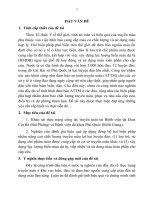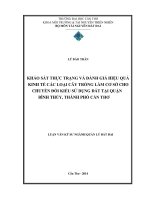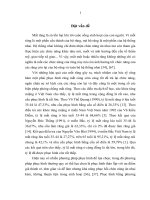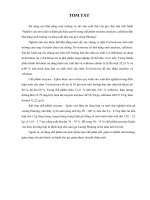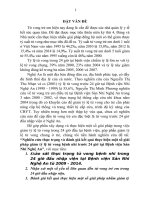Nghiên cứu thực trạng và nguy cơ mắc bệnh nghề nghiệp do vi sinh vật ở nhân viên y tế tại thành phố cần thơ và đánh giá hiệu quả biện pháp can thiệp tt tiếng việt
Bạn đang xem bản rút gọn của tài liệu. Xem và tải ngay bản đầy đủ của tài liệu tại đây (495.29 KB, 27 trang )
MOET
MOH
NATIONAL INSTITUTE OF OCCUPATIONAL AND
ENVIRONMENTAL HEALTH
---------------------
BUI THI LE UYEN
STUDY THE SITUATION AND THE RISK OF
OCCUPATIONAL DISEASES CAUSED BY
MICROORGANISMS IN HEALTH WORKERS IN
CAN THO CITY AND EVALUATE THE EFFECTIVENESS
OF INTERVENTIONS
Major: Occupational health
Code: 62.72.01.59
SUMMARY OF DOCTORAL THESIS IN MEDICINE
Ha Noi, 2019
THE THESIS WAS COMPLETED AT
NATIONAL INSTITUTE OF OCCUPATIONAL AND
ENVIRONMENTAL HEALTH
SUPERVISORS
1. Assoc. Prof., PhD. Ta Thi Tuyet Binh
2. Assoc. Prof., PhD. Tran Thi Ngoc Lan
Reviewer 1: Assoc. Prof., PhD. Nguyen Van Son
Reviewer 2: Assoc. Prof., PhD. Nguyen Minh Vuong
Reviewer 3: Assoc. Prof., PhD. Luong Mai Anh
The thesis was presented at the Academy Thesis Evaluation Council
met at National Institute of Occupational and Environmental Health,
at ….., …… , 2019.
The thesis can be found at:
1. National Library of Vietnam
2. National Institute of Occupational And Environmental Health
1
BACKGROUND
During the working process, HCWs must directly contact
patients, swabs, hazardous medical wastes that are likely to be
exposed to dangerous infectious diseases such as tuberculosis,
hepatitis B, hepatitis C, HIV infection, SARS, ... Among the group of
5 microbiological diseases insured in Vietnam, hepatitis B and
occupational disease accounts for the highest proportion, mainly in
HCWs [4], [5].
According to WHO, the risk of HBV infection is 18-30%,
HCV is 1.8% after occupational exposure in HCWs [6]. Studies in
Vietnam also indicate that HCWs are at high risk of being exposed to
pathogenic microorganisms, especially HBV [8], [9]. In Can Tho in
the period of 2011-2016, there were 103 occupational health workers
reported with occupational accidents, the prevalence of HBV virus
was 16.2% [10], [11].
The fact that the cases of occupational exposure are not
reported, cared for, properly monitored, occupational safety and health
(OSH) have not been given adequate attention in the whole country in
general and in the city. Can Tho in particular. Therefore, the topic
"Study the situation and risk of occupational diseases caused by
microorganisms in health workers in Can Tho city and evaluate the
effectiveness of interventions" was implemented with the following
objectives:
1.
Assessment of risk factors for occupational diseases caused by
microorganisms in health workers in Can Tho city;
2.
Describe the status of hepatitis B and C virus infection among
health workers at some Can Tho city hospitals in 2016-2017;
3. Evaluate the effectiveness of intervention solutions.
2
* New contributions of the thesis:
The thesis is a scientific study that has practical and urgent value. The
thesis provides new research results about risk factors for occupational
diseases caused by microorganisms in health care workers (HCWs);
the situation of hepatitis B and C infection among health workers at
some Can Tho city hospitals in 2016-2017; and assessment the
effectiveness of communication interventions on prevention of
occupational diseases by microorganisms for all HCWs at 6 health
facilities. Besides, researcher has organized vaccination for Hepatitis
B for 293 HCWs who registered voluntarily to participate. The results
of the thesis has contributed to suppose the effective interventions in
health protection and care for health workers, especially for prevention
of work-related diseases caused by microorganisms. Some specific
results of the thesis:
- Determining some high risk factors due to exposing of
microorganisms of health workers in health facilities of Can Tho city:
the frequency and the rate of expose to blood, body fluid is high
(61.7%); damage caused by sharp objects (12.5%), knowledge and
practice of prevention of work-related diseases, especially workrelated diseases caused by micro-organisms of health workers is still
low,
almost
no
vaccination
against
hepatitis
B.
- The rates of hepatitis B and hepatitis C virus infection in health
workers studied were 9.7% and 0.5%, respectively.
- Knowledge and practice of health workers on prevention of workrelated diseases significantly improved after the intervention: The
right knowledge increased from 62.9% to 91.7%; correct practice
increased from 75.4% to 88.8%; 100% of qualified health workers
voluntarily vaccinated against hepatitis B
* Structure of the thesis:
The thesis consists of 118 pages with 4 chapters and the following
sections: Introduction: 02 pages; Chapter 1 - Literature review: 33
pages; Chapter 2 - Subjects and research methods: 21 pages; Chapter 3
- Result: 28 pages; Chapter 4 - Discussion: 30 pages; Conclusion: 02
pages; Recommendations: 02 pages
References: 130 documents (53 in Vietnamese and 77 in English).
3
Chapter 1. INTRODUCTION
1.1. Labor in health facilities and occupational risk factors
1.1.1. Labor in health facilities
In Vietnam, there are about 441,446 health workers in the health
sector, of which the number of doctor is 73,567, the number of
physician is 54,466, the number of nurse, technician and midwive are
148,098 [17].
In 2016, Can Tho City has 134 health facilities including: 26
hospitals, 20 regional general clinics, 3 maternity homes and 85
commune health stations; With over 5,545 health workers, including
1,918 doctors, 652 physicians, 2,531 nurses and 444 midwives;
Among 5,150 beds, there are 4,636 beds in hospitals, 50 beds in
regional general clinics, 13 beds in maternity homes and 451 beds in
commune and ward health stations. With a large workforce in the
health sector, OSH and occupational health care for health workers in
our country in general and in Can Tho city in particular are very
important in the current period [18].
1.1.2. Occupational harm factors in health facilities
The health sector is a specific labor industry with heavy labor
intensity, physiological stress, working environment conditions with
many factors of occupational diseases affecting health of health
workers. Factors of OSH for HCW can be classified into 2 groups:
- Non-contagious risk factors: physical, chemical, labor
organization, occupational psychology, ergonomics, etc.
- Contagious risk factors: blood, body fluids, swabs, medical
waste and injuries caused by sharp objects... [19], [20].
1.1.3. Occupational hepatitis B and C virus
Occupational disease HBV, HCV caused by HBV, HCV virus
during labor process. Currently, in addition to the HBV vaccine, an
important preventive measure is health education and adherence to
standard precautions. Any HCW can be infected with HBV, HCV by
contact with patient samples containing virus during working. In order
to diagnose HBV and occupational disease, it is necessary to base on
occupational exposure, exposure time, guarantee period, clinical and
subclinical symptoms as prescribed [4], [14], [15].
4
1.2. Actual situation of hepatitis B and C virus in health workers
1.2.1 Studies in the world
According to WHO, every year in Europe, there is 304,000
HCWs will be exposed to HBV, 149,000 HCWs will be exposed to
HCV, 22,000 HCWs will be exposed to HIV and the likelihood of
infection after occupational exposure will be <0.3–4.4% for HIV, 0.5–
39% for HCV and 18–37% for HBV [40], [72]. Ogundele's study
(2017) conducted on 209 health workers showed that the prevalence of
HBsAg was 6.7%, the prevalence of HCV was 8.1%, and the coinfection with HBV and HCV was ± 0.1% [73] . The study of Adriana
Garozzo (2017) conducted in 10 years, 229 out of 3,138 HCV infected
HCV detected (7.3%) [74].
1.2.2 Studies in Vietnam
In Vietnam, there are 34 types of work-related diseases covered,
among more than 28,000 workers who were compensated for workrelated diseases, there were 397 cases of work-related diseases caused
by microorganisms, accounting for 1.43% [75]:
Table 1.1. Statistics of work-related diseases caused by
microorganisms in Vietnam [75]
Occupatio-nal
1991- 2001- 2006- 2010- 2014- Total cases
diseases caused by
2000 2005 2009 2013 2016
n (%)
microorganisms
HBV,HCV
50
61
32
135
41
319 (80,4)
Tuberculosis
37
6
7
21
71 (17,9)
Leptospira
5
1
0
0
6 (1,5)
HIV
1
1 (0,3)
Total occupational diseases caused by microorganisms
397 (100,0)
Total occupational diseases caused by microorganisms 397/27.878 (1,43%)
In Vietnam, HCV infection is less than HBV, Nguyen Thuy
Quynh (2009) showed that 16.4% of HCWs were HBsAg positive [9];
In the study of Ha The Tan (2010), the proportion of HCWs with
HBsAg antibodies accounted for 9.7%, Anti-HBs carriers accounted
for 37.8%, HCV infection rates accounted for 1.14% [51].
5
1.3. Interventions to prevented infection by microorganisms
From the theoretical framework of occupational risk control
interventions (WHO - ILO), it is proposed to take measures to prevent the
spread of diseases caused by microorganisms and implementing standard
preventive measures, in combination with operational control policies,
techniques, environmental sanitation control and policies to minimize
risks for individuals (use of labor protection, vaccinations, policies…)
[78], [79].
Chapter 2. SUBJECTS AND METHODS OF THE STUDY
2.1. Subject, location and time of study
2.1.1. Research subjects:
Study subjects include public health facilities in Can Tho and
health workers working in selected health facilities:
- Subjects of health care: Specialized hospitals, general hospitals or
medical centers (with medical examination and treatment activities);
- Subjects of health workers: doctors, surgeons, technicians,
physicians, nurses and midwives working at the selected medical
examination and treatment facilities.
2.1.2. Research location
Research at 6/23 public health facilities at the public level:
Maternity Hospital, Eye – Odontology, Otorhinolaryngology Hospital,
O Mon District Hospital, Thoi Lai District Health Center, Phong Dien
District Health Center.
2.1.3. Research time
From September 1, 2015 to December 31, 2017, include:
- Phase 1: From September 1, 2015 to March 30, 2016: Assessing
OSH conditions and exposure to microorganisms risk factors of HCWs.
- Phase 2: From April 1, 2016 to December 31, 2016:
Determining the actual situation of HBV, HCV infection in HCWs;
survey knowledge, practice on occupational hygiene, prevention of
work-related diseases of health workers at selected health facilities.
6
- Phase 3: From January 1, 2017 to December 31, 2017:
Implementing and evaluating effective interventions to prevent
microorganisms infection in HCWs.
2.2. Research Methods
2.2.1. research design
- The study describes cross-sectional, interventional evaluation.
2.2.2. Sample size
- The sample size of health facilities under objective 1 is 06/23
health facilities in Can Tho city.
- The sample size of HCWs according to objective 2 and goal 3 is
calculated using formula based on formula:
- With: Z1 - α/2 = 1,96; p = 16,2% [77]; d = 0,03.
The smallest number of health workers participating in the study
was 580 subjects. In fact, 626 HCWs participated in the study.
2.2.3. Sampling method
Health facilities: randomly selecting 1 general hospital, 3
specialized hospitals and 2 medical centers to conduct research.
Medical staff: select all health workers at 06 health facilities in
accordance with selected criteria to conduct research.
2.3. Variables, research indicators
2.3.1. Risk factors for occupational diseases caused by microorganisms
Monitoring the labor environment according to the Technical
Routine of the Institute of Occupational Health and Environment [96].
Evaluate as follows:
- Microclimate: Circular No. 26/2016 / TT-BYT; Lighting:
Circular No. 22/2016 / TT-BYT.
- Aerobic bacteria, mold: Clean room standard of the Ministry
of Environment of Singapore (< 500 cfu/m3) [96].
Working conditions of HCWs through interviews.
7
Knowledge and practice of health workers (Using
questionnaires and checklists to survey):
- Knowledge has 10 main content with 33 questions, each
question correctly answers 1 point, general knowledge is correct when
reaching ≥ 70% of the maximum total points (≥ 23 points);
- Practice includes 03 main contents and has 11 evaluation
criteria, 1 point for each criterion correctly executed, general right
practice for achieving ≥ 70% of the maximum total points (≥ 08
points).
2.3.2. Determining the status of hepatitis B, C virus infection
Perform serum test for HBsAg, Anti HCV according to the
Ministry of Health's Technical Routine.
2.3.3. Communication intervention and implementation of measures
to prevent occupational diseases caused by microorganisms for
health workers
Develop communication materials based on information, results
of implementation of Goal 1 and organize training for health workers.
Conduct knowledge assessment, practice before - after the
intervention by interview questionnaires and checklists to evaluate the
effectiveness of the intervention.
Vaccinate HBV vaccine for eligible HCWs (HbsAg, anti-HBs
negative) and agree to vaccinate.
2.4. Methods of controlling deviations, analyzing and processing data
2.4.1 Control of deviations
Provide detailed on content, techniques, and skills used in
research. Organize the investigation, try adjusting the questionnaire.
2.4.2. Processing and analyzing data
Checking the completeness and suitability of the information
collection form; Entering and processing data on SPSS 18.0 software;
Descriptive statistics, analysis (χ2 test, t-test test).
2.5. Ethical issues in research
All study participants are completely voluntary, and the
respondent has the right to refuse to be interviewed.
8
This study did not have any effect on local customs and cultural
traditions. The research protocol was approved by the Ethics Council
of the Institute of Occupational Health and Environment.
Chapter 3. RESULTS
3.1. Occupational risk factors by exposing microorganisms in
health workers in Can Tho city in 2015-2017
3.1.1. General characteristics of health facilities
The study was conducted at 6 health facilities with 626 health
workers. The distribution of medical staff at the facilities is as follows:
Can Tho Maternity Hospital accounts for 37.5%, Ear-Nose-Throat
Hospital 4.8%, Odonto-Stomatology Hospital 7.7% , O Mon District
General Hospital 28%, Thoi Lai District Medical Center contributed
11.3% while Phong Dien District Medical Center accounted for 10.7%.
The actual bed / plan ratio is 1.3 / 1; The average capacity of
using beds is 112.1%; Number of doctors / beds: 0.16 (ranges from 0.09
to 0.22); Average number of doctors per day: 42.5 visits (ranging from
35.3-50.5).
3.1.2. Occupational risk factors by exposing microorganisms in
health workers
Table 3.5-6. Monitoring results of microclimate and light factors in
working environment at researched facilities (n = 229)
Number of
Results
unstanderdized sample
Environmental factors Mean ± SD
(Min-Max)
Number Rate (%)
Temperature (oC)
28.9 ± 1.8
19.5-39.2
6
2.6
Moisture (%)
68.1 ± 8.8
44.2-83.5
11
4.8
Wind speed (m/s)
0.27 ± 0.10
0.20-1.40
0
0.0
Light (Lux)
779 ± 1844
100-13800
64
27.8
It can be seen in the table that the number of samples does not meet
hygienic standards: Temperature 2.6%; Moisture 4.8%; light 27.8%.
9
Table 3.7-8. Results of tested aerobic bacteria and molds in the
working environment at researched facilities (n = 300)
Number of
Results
unstanderdized sample
Environmental factors Mean ± SD
(Min-Max)
Number
TL (%)
Aerobic (cfu/m3)
664 ± 647
86- 5145
119
39.7
Molds (cfu/m3)
560 ± 423
130 - 2230
102
34.0
The table above shows that the number of non-standard samples
is aerobic 39.7%, molds 34%.
3.1.3. Working conditions of health workers
The survey showed that 100% of health workers were equipped
with masks, hats or goggles / veils; 92.5% equipped with gloves;
97.8% are equipped with robes. Health workers have large and
stressful workloads of 81.2% and 73.5% respectively; The exposure
rate for microorganisms is 63.1%, while the exposure rate for toxic
gases and chemicals is 48.9%.
Figure 3.2. Risk of exposure to microorganisms due to
an occupational accident (n = 626)
61.7% of health workers are frequently exposed to
microorganisms due to occupational accidents. 7.2% of employees
have been splashed with blood and body fluids. 12.5% of employees
were hurt by sharp objects (due to 37.2% infusion, 20.5% tests, 26.9%
surgical procedures, 15.4% washing tools, medical waste disposal
14.1%);
10
3.1.4. Knowledge and practice of occupational prevention due to
microorganisms of health workers
Figure 3.4 and 3.6. Knowledge and practice of health workers
Knowledge and practice of 626 subjects reached 62.9% and
75.4% respectively. The inadequated knowledge group have the risk
of being pierced by sharp objects as 1.76 times higher as the adequate
knowledge group (95% CI: 1.06-2.91). The adequate knowledge has
1.54 times higher than the inadequate knowledge group in terms of
good practice (95% CI: 1.06-2.23), p <0.05.
3.2. The status of virus B,C infection of health workers
Figure 3.7. Positive rates of HBsAg, Anti-HBs, Anti-HCV of
the study subjects (n = 626)
11
Figure 3.3 describes the positive HBV/ HCV mark rate of 626
health workers. Accordingly, HBsAg positive rate was 9.7%, AntiHbs positive rate was 43.5% while Anti-HCV positive rate was 0.5%.
Table 3.19. The prevalence known and newly discovered HBV,
HCV status of the study subjects (n = 626)
Status of infected HBV/HCV
Number
Rate (%)
Before study period
40
65.6
HBV
In study period
21
34.4
Total
HCV
61
100.0
Before study period
1
33.3
In study period
2
66.7
Total
3
100
Among 61 cases of HBV infection, 21 cases (34.4%) were
newly discovered; Among 03 cases of infection, there were 02 cases
(66.7%) newly discovered.
Table 3.20. The prevalence of HBV infected of Health workers (n=626)
HBV infected
OR
χ2
Sex
Infected
Non-infected
Total
(95% CI)
p
n
%
n
%
n
%
Male
Female
Total
30 16.3 154
83.7 184 100
2.58
12.75
31
7.0 411
93.0 442 100
(1.51-4.41) <0.001
61
9.7 565
90.3 626 100
The rate of HBV infection in male group is 2.58 times higher
than female group (95% CI: 1.51-4.41). The difference was
statistically significant with p <0.001
12
Table 3.24. HBV infection rate by occupational injury
of health care workers (n = 626)
Injury
HBV infected
Tổng
caused by
OR
Infected
Non-infected
sharp
(95% CI)
n
%
n
%
n
%
objects
100
Yes
14
17.9
64
82.1
78
2.33
No
47
8.6
501 91.4 548 100
(1.22-4.47)
Tổng
61
9.7
565 90.3 626 100
χ2
p
6.819
0.009
The group damaged by sharp objects was 2.33 times more likely
to be infected with hepatitis B (95% CI: 1.22-4.47). The difference
was statistically significant with p <0.05.
Table 3.21. the HBV infection rate by seniority work of health
workers (n=626)
HBV infected
Seniority
work
χ2
p
Total
Infected
Non-infected
n
%
n
%
n
%
> 10 years
32
14.1
195
85.9
227
100
5 - 10 years
17
8.3
187
91.7
204
100
< 5 years
12
6.2
183
93.8
195
100
Total
61
9.7
565
90.3
626
100
7.086
0.008
The rate of hepatitis B infection increases gradually according to
the seniority of the study subjects. The group with seniority less than 5
years has the prevalence of 6.2%. In the group with seniority from 510 years, this rate increased to 8.3%. The group with seniority over 10
years has the incidence of 14.1%. The difference was statistically
significant (p <0.05).
13
3.3. The effectiveness of intervention methods
3.3.1. Knowledge and practice before - after the intervention of
health workers
Figure 3.8. Knowledge and practice of health workers before and
after the intervention (n = 626. p (McNemar Test) < 0.001)
After the intervention, the percentage of correct knowledge
increased from 62.9% to 91.7%; The ratio of correct practice increased
from 75.4% to 88.8%, p <0.001.
Table 3.28. Proper knowledge about occupational infection
prevention among health workers before and after the
intervention (n = 626)
PrePostp
Efficience
intervention intervention (McNemar
Knowledge content
index
test)
n
%
n
%
Hand hygiene
344 55.0 579 92.5 <0.001
68.2
Personal protective
354 56.5 568 90.7 <0.001
60.5
equipment
Preventive isolation
407 65.0 553 88.3 <0.001
35.8
Epidemic prevention
464 74.1 573 91.5 <0.001
23.5
Disinfection-sterilization
458 73.2 582 93.0 <0.001
27.0
14
Knowledge content
PrePostp
Efficience
intervention intervention (McNemar
index
test)
n
%
n
%
Management of medical
518 82.7 569 90.9 <0.001
9.9
textiles
Medical waste
498 79.6 582 93.0 <0.001
16.8
management
Clean surface environment
528 84.3 572 91.4 <0.001
8.4
Health management of
391 62.5 521 83.2 <0.001
33.1
medical personnel
Knowledge of hepatitis
394 62.9 599 95.7 < 0.001
52.1
B/C
Training programs on occupational disease prevention for health
workers achieved high efficiency. The knowledge of health workers is
improved in all areas. The difference was statistically significant with
p <0.001.
Table 3.31. Results of interventions on proper practice of
preventing infectious diseases caused by microorganisms
in health workers (n=626)
Pre-intervention Post-intervention
p
Practical
Efficience
(McNemar
content
index
n
%
n
%
test)
Hand
390
62.3
502
80.2
28.7
<0.001
hygiene
Personal
protective
502
80.2
600
95.8
19.5
<0.001
equipment
Preventive
482
77.0
564
90.1
17.0
<0.001
isolation
The percentage of subjects who practice proper hand hygiene
increased from 62.3% to 80.2%. The practice rate of using personal
protective equipment increased from 80.2% to 95.8%. Health care
management practice increased from 77.0% to 90.1%. The difference
was statistically significant with p <0.001
15
3.3.2. Vaccination results for hepatitis B vaccine
Table 3.32. Vaccination rates for hepatitis B vaccines of health
workers at health facilities before and after the intervention
(n=626)
Vaccination rate for
n
%
Efficience
hepatitis B vaccine
index
% (p)
Pre-intervention
256
40.9
114.4
Post-intervention
293
46.8
(p < 0.001)
Total
549
87.7
After the intervention, the percentage of health workers
vaccinated increased from 40.9% to 87.7%. The efficiency index is
114.4%. The difference was statistically significant with p <0.001.
Chapter 4. DISCUSSION
4.1. Risk factors for occupational diseases caused by
microorganisms in health workers in Can Tho City in 2015-2017
4.1.1. General information about research facilities
The study results showed that in all the hospitals participating in
the study, the number of actual beds always exceeded the planned
number of beds (1.3/1), the capacity of using beds was 112.1%. The
average number of medical visits / day at 6 medical facilities is 535.3.
The average number of visits per doctor per day is 42.5 (ranging from
35.3-50.5). The above data showed that the number of doctor visits per
day in hospitals exceeds the general rule of 35 visits / day. Hospital
overcrowding is a painful problem of the medical industry and the
whole society. Patients put too much expectation on health workers,
the health sector also requires physicians to perform their duties well,
but the stakeholders have not yet fairly recognized the pressures of
health workers. Many studies have shown that health workers have
16
many risks affecting health such as stress, biological risk, etc. [22],
[23], [24]. In order to minimize the effects of occupational risk factors
on the health of health workers, leaders at all levels and trade unions
in the health sector are interested in, direct as well as each health
worker himself needs to be proactive. sense of responsibility in
implementing OSH in accordance with regulations.
4.1.2. Risk factors for occupational diseases caused by
microorganisms in health workers
Monitoring results of microclimate in working environment at 6
health facilities showed that 2.6% of temperature samples, 4.8% of
humidity samples, 27.8% of light samples did not meet the labor
hygiene standards (table 3.1). High temperatures in the working
environment lead to reduced attention, coordination, reduced
stimulation and reflex rate of HCWs. High humidity is a good
environment for mold to quickly produce, stimulating directly into the
airway mucosa leading to inflammation, increased secretion and
bronchospasm leading to symptoms of coughing, sneezing, shortness
of breath, etc. Out, in hospitals, when the humidity is high, it is easy to
cause fire, damage to medical equipment. Inadequate light can make
poor vision lead to occupational accidents, health facilities need to be
equipped with adequate technical systems for lighting fixtures
(fluorescent lamps) to ensure hygienic standards for general lighting.
and locally, depending on the nature of each job. Research on working
conditions and health care of health workers by Nguyen Bich Diep
(2009) showed that, at the central and provincial health care centers,
preventive and preventive care facilities in Hanoi, Nam Dinh, Hai
Phong, Hue and Khanh Hoa. , ... 59.3% of samples measured in the
labor environment did not meet the permitted hygienic standards [74].
The pollution of microorganisms in the air can affect patients
during treatment and recovery as well as affect the health of health
17
workers. The result of anaerobic bacteria test in the air is 664 ± 647
cfu / m3, ranging from 86-5145 cfu / m3 and there are 119 samples
that do not meet the standard of TCVSCP accounting for 39.7%; The
average number of molds in the air is 560 ± 423 cfu / m3, ranging
from 130 - 2230 cfu / m3 and there are 102 samples that do not meet
labor hygiene standards, accounting for 34.0% (Table 3.2). Improving
air quality in hospitals is important for health and safety requirements
in health facilities. Nguyen Quoc Tuan's study investigated
microbiological contamination in the air of operating rooms and
recovery rooms in some hospitals in Ho Chi Minh City, showing that
when the number of microorganisms in the air varied from 64.2 1247.8 cfu / m3, mostly concentrated in the range of 200-500 cfu / m3
accounting for 70% (23/33 rooms). This is a very low rate that needs
attention and improvement [102].
4.1.3. Working conditions of health workers through interviews
Interview results showed that most health workers are fully
equipped with labor protection, in addition, the high and stressful
workload is reflected in the majority, respectively 81.2% and 73.5%;
exposure to microorganisms and toxic gases and chemicals is also an
unfavorable working condition for 48.9-63.1% of health workers.
Many studies have shown that health workers have many risks
affecting health such as stress, biological risk, etc. [24], [71], [105].
Survey of 626 HCWs with 386 cases of regular job contact with
blood and body fluids accounted for 61.7%; 78 cases have been hurt
by sharp objects accounting for 12.5%; 45 cases have been splashed
with blood and body fluids of patients accounted for 7.2% (chart 3.1).
In the 78 cases that have ever been damaged by sharp objects, the
most common cause was infusion accounting for 37.2%, the lowest
was medical waste disposal accounting for 14.1%. When being injured
by sharp objects, 61.5% of HCWs treated their wounds as prescribed,
18
48.7% of HCWs reported, made follow-up records, 32.1% took
preventive medicine, 42 , 3% had tests (HBV and HIV), 6.4% were
vaccinated. Improper treatment of wounds will increase the risk of
infection of health workers. Compared with other studies, showing the
similarities, actual situation of occupational accidents, the risk of
exposure to microorganisms of HCWs is quite high, as the study by
Nguyen Thuy Quynh showed the frequency of exposure to blood
transfusion of HCW patients was 119.4 / 1000 persons / 4 months (of
which the frequency of cutaneous damage was 100.7 / 1000 persons /
4 months; the frequency of exposure due to splashes of blood was 18.7
/ 1000 people / 4 months [9]; Research by Nguyen Ngoc Diem at the
National Hospital of Dermatology in 2012: 92% of nurses suffered
trauma from sharp objects in the past year, the most likely cause was
the bottle's shell. / vial of distilled water accounts for 61.5%, sterile
needle injury accounts for 30.6% and contaminated needle accounts
for 7.9% [26]; Rahul Sharma's study in Delhi, India showed that 79.5
% HCWs have been hurt injuries due to sharp objects [44].
4.1.4. Knowledge and practice of prevention of occupational diseases
caused by microorganisms of medical staff.
For HCWs the prevention of harmful factors is a very important
goal, in which knowledge and practice on prevention of HCWs plays a
very important role as the basic foundation for implementing
measures. protection against harmful factors in daily professional
activities, where interventions can be effected through training to
improve knowledge, monitoring the ultimate goal of improving
practice, when knowledge is available. and good practices will become
protective factors and vice versa, risk factors [113], [114], [115].
In this study, we investigated knowledge of work-related
diseases prevention of 626 HCWs, showing that 62.9% of HCWs were
knowledgeable (Figure 3.2). Compared with some other studies, it also
19
showed that the proportion of health workers with correct knowledge
about the prevention of work-related diseases is at an average level,
such as that of Mohammed Mustafa in Sudan (2015) with 70.0% [31],
Le Thi Minh Nguyet and Bui Thi Hanh (2015) had 54.56% [56], and
Quach Thi Sau (2013) had 46.5% [58]. Poor knowledge is one of the
reasons leading to the increase in the incidence of work-related
diseases over time.
The study of assessing direct practice depending on the specific
work of 626 health workers showed that the rate of practice in
prevention of work-related infections reaches 75.4% (figure 3.2).
Practices on disease prevention by microorganisms of HCW are
divided into 03 contents. The content of personal protective equipment
has the highest rate of 80.2%, the content of managing health care
products reaches 77.0% and the content of regular hand hygiene
reaches 62.3%. In a study of Talla Paul et al at 4 hospitals in Yaoundé,
the proportion of health workers with good practice in preventing
HBV infection was 42.9% [112]. According to research by Nguyen
Thi Diem, only 66.5% of health workers always wear gloves to
perform professional work [115]; In the study of Nguyen Duc Cuong,
38.6% of HCWs wore gloves when working, 60.8% of HCWs wore
masks when working [111]. The research of Le Thi Minh Nguyet and
Bui Thi Hanh has the practice of infection control right practice is
81.1%, routine hand washing is 74.1%, hand sanitizer with alcohol
solution reaches 74.6%, dressing change process reached 90.26% [56].
4.2. Actual situation of hepatitis B and hepatitis C of health workers
At the time of the study, we performed HBV and HCV markers
for all HCWs, positive HBsAg result was 9.7%, Anti-Hbs positive was
43.5%, Anti-HCV was positive. is 0.5% (chart 3.3). Among 61 cases
of hepatitis B infection, 34.4% were newly discovered; Among 03
cases of infection, there were 02 newly discovered cases (Table 3.3).
20
This result showed that many subjects did not know their status until
participating in the study, which greatly affected the monitoring and
treatment of their disease, besides not being detected. Timely disease
will contribute to increase the risk of spreading the disease to other
groups of subjects, this is an issue that needs attention. Le Van Hoan's
study in Hue (2009) the prevalence of HBsAg in HCWs was 9.0%
[118]; In the study of Vo Hong Minh Cong, the rate of HBsAg
positive was 6.05, Anti-Hbs was 33.3% [78]; In Dang Thi Bich
Phuong's study, the rate of HCWs in Can Tho infected with HBV in
the study was 16.2% [11]; A study by Adriana Garozzo (2017)
showed that HCV infection was detected in 229 out of 3,138 HCWs
(7.3%). Among HCV infected HCV, 43% are nurses, 34% of doctors
and surgeons and 23% are other employees [16]; Ogundele's study in
Nigeria showed that the prevalence of HBsAg was 6.7%, the
prevalence of HCV was 8.1%, and the co-infection with HBV and
HCV was ± 0.1% [73].
Considering the rate of hepatitis B infection by gender of HCWs
(Table 3.4), we found that the prevalence of HBV was higher among
males than females, at 16.3% and 7.0%, respectively. , this difference
is statistically significant with p <0.001. Other studies also show that
the prevalence of HBV in men is higher than that of women like
Nguyen Thi The Tram [127] and Dang Thi Bich Phuong [11].
The prevalence of hepatitis B in the group of sharp objects
pierced skin was higher than the group not infected by sharp objects,
this rate was 17.9% and 8.6%, p <0.05 (Table 3.5). A study by Luiz
AS Ciorlia, Dirce MT Zanetta at a Brazilian hospital noted that workrelated injuries increased the risk of HBV infection by 2.49 times in
HCW with p = 0.012 [128]. In Dang Thi Bich Phuong's study, the
prevalence of hepatitis B infection in the group of people who had a
needle stick was 59.2%, higher than the group without a needle stick
21
by 40.8% [11]. Research by Du Hong Duc et al (2014) at health
facilities in Hanoi and Nam Dinh showed that people who have been
injured by sharp objects are 4.1 times more likely to be infected with
hepatitis B than HCWs who have not been injury [37].
Through the study, we found that the rate of hepatitis B
infection increases gradually with the seniority of health workers, in
the group with seniority of <5 years, the percentage of hepatitis B
members is 6.2%, in the group of 5 - 10 years is 8.3%, in the group
with more than 10 years of seniority is 14.1%, this difference is
statistically significant with p <0.05. This result is similar to the
studies of Vo Hong Minh Cong [78], Le Van Hoan [118], Dang Thi
Bich Phuong [11], Luiz AS Ciorlia, Dirce MT Zanetta [128]. This
showed that the longer the career will increase the risk of exposure to
weak exposure, increasing the likelihood of disease.
Thus, HBV and HCV infection status varies among study areas,
this difference may be affected by many factors such as: working
conditions, equipment and implementation of labor protection. There
are differences in health facilities, differences in knowledge about the
practice of prevention of HBV, HCV among HCWs in each study
area.
4.3. The effectiveness of intervention solutions
4.3.1. Knowledge, practice before - after the intervention of health
workers
Exposure prevention is the main strategy to reduce the risk of
microbiological pathogens transmission to HCWs, the initial research
results show that the knowledge and practice of HCWs in this work is
low, thus improving Awareness and practice are of utmost importance.
We have conducted training on prevention of occupational infections
for health workers, after intervention, knowledge and practice of
health workers increased significantly, the proportion of correct
22
knowledge increased from 62.9% to 91.7% The ratio of correct
practice increased from 75.4% to 88.8%, this difference is statistically
significant with p <0.001. This showed the very positive effect of the
intervention process.
4.3.2. Results of vaccination against hepatitis B
After implementation of the training, 100% of HCWs eligible
for vaccination (293 people with negative HBsAg and Anti HBs test
results) agreed to vaccinate against HBV, the effectiveness index was
114, 4% with p <0.001. Immunizing with the hepatitis B vaccine is the
most important measure for preventing HBV in HCWs. Health
workers who are suffering from an acute illness or who carry the virus
are at high risk of infecting others. The risk of transmission of
hepatitis B virus is much higher than that of hepatitis C and HIV [13],
[121]. The rate of vaccination against hepatitis B in HCVs after
intervention in our study was higher than that of Abdel-Nasser Elzouki
et al at five hospitals in Eastern Libya (52.0%) [119], Research of
Mustafa et al. in Sudan in 2015, 72.6% of HCWs were vaccinated
against hepatitis B [38]. Immunization with the hepatitis B vaccine is
the most important measure to prevent hepatitis B in HCWs, and
health facilities need to take more specific actions in caring workers as
prescribed by law.
4.4. Limitations of the topic
Research in a small scale (6/23 public health facilities under the
Department of Health) so the results have not been generalized for all
health facilities throughout the city.
The study used a set of pre-designed questionnaires, some
retrospective questions in the past, so it may encounter recall errors
during the investigation.
23
CONCLUSION
1. Risk factors for occupational diseases caused by
microorganisms in health workers
- Occupational health organization: 6/6 health facilities have not
organized training courses on occupational safety and health, health
checks before arranging jobs, occupational diseases, vaccinations. .
- Overloaded, stressful work: Statistics/ planning beds: 1.3/ 1.0;
Average of doctor visits/ day: 42.5 times; 81.2% of health workers
think that the workload is high; 73.5% had stressful jobs, 8.9% had
ever been abused;
- Occupational risk accidents: 12.5% of health workers have
been hurt by sharp objects; 7.2% had been splashed, 61.7% had
frequent contact with blood, body fluids of the patient;
- Knowledge and practice on occupational disease prevention of
medical staff are not good: Knowledge has not reached 37.1%,
practice has not reached 24.6%.
2. Actual situation of hepatitis B and C infection in HCWs
- HBsAg positive was 9.7% (21/61 cases detected at the time of
the study), Anti-Hbs positive was 43.5%; Some factors related to the
status of hepatitis B infection in the study subjects such as gender,
seniority, damage from sharp objects.
- Anti-HCV positive is 0.5% (2/3 cases detected at the time of
research).
3. Effective intervention solution
The results of intervention after 6 months have shown the
following effects:
- The percentage of correct knowledge increased from 62.9 to
91.7%, the right practice rate increased from 75.4 to 88.8%, with p<0.001.
- 100% of HCWs (293 people) eligible for testing (with HBsAg
and Anti-HBs negative) voluntarily vaccinated against hepatitis B.
